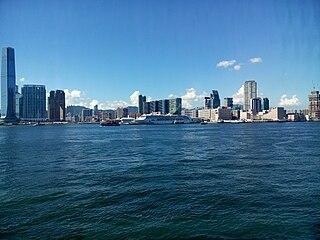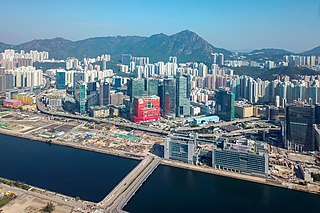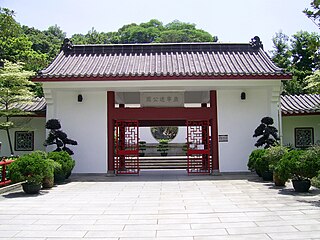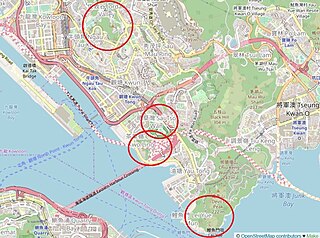
Kowloon is an urban area in Hong Kong comprising the Kowloon Peninsula and New Kowloon. It has a population of 2,019,533 and a population density of 43,033/km2 (111,450/sq mi) in 2006. It is one of the three regions of Hong Kong,along with Hong Kong Island and the New Territories,and is the smallest,second most populous and most densely populated.

Kowloon Bay is a bay within Victoria Harbour and an neighbourhood within Kowloon,Hong Kong.

Kowloon Bay is a station on the Hong Kong MTR Kwun Tong line. It is located between Choi Hung and Ngau Tau Kok stations in Kowloon East. The station was opened in 1979.

Ngau Tau Kok is a station on the Hong Kong MTR Kwun Tong line. It is located in the Ngau Tau Kok area of Kowloon East,between Kwun Tong and Kowloon Bay stations. It was among the earliest stations in the network,becoming operational on 1 October 1979.

Kwun Tong is a station on the MTR Kwun Tong line in Hong Kong. The station opened on 1 October 1979 as the eastern terminus of the first phase of the Kwun Tong line,until the Eastern Harbour Crossing to Quarry Bay opened on 6 August 1989. It is located in the Kwun Tong area,between Lam Tin and Ngau Tau Kok stations.

Kwun Tong is one of the 18 districts of Hong Kong. It is located in Kowloon,and is the easternmost and southernmost district in Kowloon. It had a population of 648,541 in 2016. The district has the second highest population in Hong Kong,after Sha Tin District,while the income is below average. Kwun Tong District borders Sai Kung District to the east,Wong Tai Sin District to the north,and Kowloon City District to the west. To the south is Victoria Harbour,and the Eastern District directly across on Hong Kong Island.

Prince Edward Road East and Prince Edward Road West are roads in Kowloon,Hong Kong,going in an east-west direction and linking Tai Kok Tsui,Mong Kok,Kowloon Tong,Kowloon City and San Po Kong.

Lok Wah Estate is a public housing estate located in Ngau Tau Kok,Kwun Tong,Kowloon,Hong Kong.

Kwun Tong Road is a major thoroughfare in Kwun Tong District,New Kowloon,Hong Kong.

KMB Route 1A is a bus route operated by Kowloon Motor Bus (KMB) in Hong Kong. It runs between Star Ferry and Sau Mau Ping (Central) and provides air-conditioned service. The route runs via Tsim Sha Tsui,Yau Ma Tei,Mong Kok,Kowloon City,San Po Kong,Ngau Tau Kok,Kwun Tong,and Sau Mau Ping.

Lower Ngau Tau Kok (II) Estate was a 7-block public housing estate built on reclaimed land in Ngau Tau Kok,Kwun Tong,Kowloon,Hong Kong,located opposite Kowloon Bay station on the MTR. The demolition of the estate started in March 2010. The estate,along with the Lower Ngau Tau Kok (I) Estate,which was demolished in June 2004,formed the Lower Ngau Tau Kok Estate. A new estate,retaining the name Lower Ngau Tau Kok Estate,is being constructed on the site.

Kwun Tong Garden Estate,or Garden Estate,is a public housing estate in Ngau Tau Kok,Kwun Tong,Kowloon,Hong Kong,developed by the Hong Kong Housing Society,near the MTR Kwun Tong line's Ngau Tau Kok station. It is the largest Housing Society estate by number of flats (4,921).
The following shows the public housing estates in Ngau Tau Kok,Jordan Valley,Kowloon Bay and surrounding neighbourhoods,in Kwun Tong District,Kowloon,Hong Kong.

Upper Ngau Tau Kok Estate is a public housing estate in Ngau Tau Kok,Kwun Tong,Kowloon,Hong Kong,located next to Kwun Tong Garden Estate and between MTR Ngau Tau Kok station and Kowloon Bay station. After redevelopment,the estate has 9 blocks developed into 3 phases.

The East Kowloon Cultural Centre is an under construction arts complex in Jordan Valley,Kowloon,Hong Kong. It will be located on part of the former site of Lower Ngau Tau Kok Estate,directly across Kwun Tong Road from Kowloon Bay station. It will be built on a 2.16-hectare (5.3-acre) site at an estimated cost of $4.1 billion and is expected to open in 2021.

Hong Ning Road Park is a public park between the districts of Ngau Tau Kok and Sau Mau Ping in Kowloon,Hong Kong. It is divided into two phases linked by a staircase. The park is distinct from the similarly-named Hong Ning Road Recreation Ground,which is located down the hill closer to Kwun Tong Town Centre.

The Four Hills of Kowloon are four hills that were historically the site of granite quarries in Kwun Tong District,New Kowloon,Hong Kong.

Ping Shan is a hill in Kwun Tong District,eastern Kowloon that lies between the communities of Ngau Chi Wan,Kowloon Bay and Jordan Valley,Hong Kong. Most of it was the Ping Shan Stone Quarry before redevelopedment into a new neighbourhood with numerous public housing estates and schools. Being unlabelled in most maps,it was often mistaken as part of the forementioned neighbourhoods and Ngau Tau Kok.





















